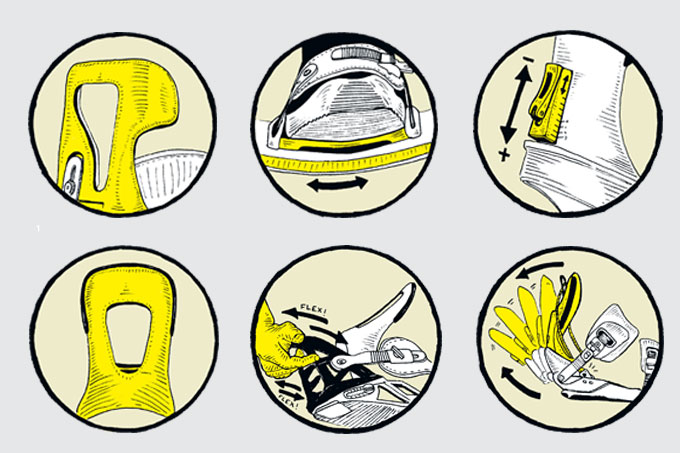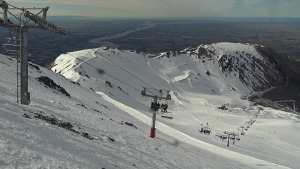Binding Tech Explained – The 2015 Gear Guide
![]()

Illustration:: Louis Macindoe
Transfer | Gear Guide
This article appears in the 2015 Transfer Gear Guide, available for free with Issue #18. Purchase HERE
Bindings; the age-old dead bolts that connect man and machine. Without these guys, we’d be no more than glorified skim boarders. Bindings have one job: to keep you connected with the craft. It seems simple, and it somewhat is. Selecting a pair of binders is pretty straight forward, but don’t skimp on it because you don’t want to end up ejecting mid air and becoming part of a YouTube ‘snowboarding fails’ compilation. Here’s the tech scoop on the latest binder offerings.
Baseplate flex
A particularly controversial area of binding technology is flexing baseplates. The question is: should base plates really flex? The answer is complicated. For a long time, the general consensus was that bindings create a dead-spot in the board’s flex pattern which creates resistance – this resistance provides that snap feeling when cracking an ollie – if a binding flexed with the board, would that not be lost? Partially, however manufacturers started adding carbon ‘pop-rods’ to their board’s years ago to counter this and the demand for flexible baseplates presented themselves when the rail revolution took off and guys really started to press-out their tricks. A flexible baseplate allows for a more balanced and natural press. Today, most manufacturers have arrived at a happy medium in delivering flex and pop – some will use a urethane base plate, others will incorporate the flex into the baseplate tolerances or have certain zones made entirely of flexible materials.
Flexible heelcups
Quite possibly the strangest technology on bindings since the appearance of the ‘winged’ highback. These heelcups are either made from a flexible material such as urethane or have tiny hinges where they connect to the base plate. The theory behind this varies from one approach to another; the urethane heelcups aim to secure the boot heel into the binding once the heel strap is fastened – proving a tighter, more conforming fit. Along with improved fit these ‘soft’ heelcups allow for side-to-side flex, perfect for pressing and tweaking. Hinged heelcups aim to do the same, the hinge allows for side to side flex without compromising the benefits of a conventional heelcup design. This technology would be best reserved for the rail guys or those who want a more skate-style feel from their setup.
Winged highbacks
For added pressing power and tweakability, the winged highback or ‘scrub hook’ has become a staple for rail riders worldwide. The design is simple; it’s basically a surface area which one can lean into and exert force upon, maximizing the press, sans effort. There’s been plenty of DIY add-on’s over the years used; PVC plumbers pipe becoming the material of choice. Luckily binding companies have created their own versions and rendered those unsightly things useless. If pressing is your game, give yourself the competitive advantage and get some binders with winged highbacks.
Quick entry
We’d be lying to you if we said we’d never tried strapping in on a lift in the hopes of beating our friends and foes for the pow runs of the day. We’ve definitely done that, and we’ll definitely do that again – after all isn’t that the dream? The quick entry binding is no new-jack; people have been trying to build the ultimate lazy-boy binders since they where first incarnated. Thankfully we where able to bypass the dark-days of step-ins and get to where we are now – the rear entry binder is the most popular of this design and really the only proven quick entry binding. There are variations, some with straps that can be fastened quicker than the conventional ratchet-ladder system, but if you want a truly dedicated binding, which allows you to strap in on the chair, there’s only one brand – we’ll let you figure that out.
Lean adjusters
Forward lean is a very personal thing, much debate – dare we say it arguments – have arisen during the discussion of forward lean settings. Theoretically speaking, based on the symmetry of our bodies and how we stand naturally – we should be running forward lean on our front foot. However it’s completely open to personal preference. Those riders who really utilize lean are generally more aggressive in their riding style and terrain preferences, pipe guys use lean to load up their knees whilst rail guys will want zero lean for pressing and balance. If you’re carving it up like a kebab shop on a Friday night, whack a few clicks of lean in there so you’re already in the attack position at all times. Thankfully most binding lean settings can be adjusted without a tool, so you can dial it in or dial it out on your own terms.
Highbacks
Highbacks are a binding’s spine. The highback’s role in determining the binding’s feel is unsurpassed when compared to any other components. Highbacks can be constructed from different materials and come in different flex patterns. A soft highback is more forgiving and flexes easier whilst a stiffer highback is more responsive and will prop you up on the more serious jumps and keep you from blowing out on those big backside turns. Highbacks also come in a variety of different sizes; lowbacks – a gift from ’90s snowboarding have made a resurgence with the ‘jibbers’ among us; allowing for more freedom and flex whilst a taller highback will naturally be restrictive but aid those who like to send it.




